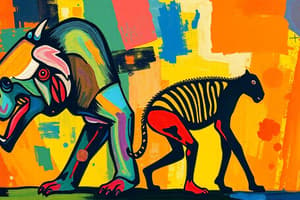Podcast
Questions and Answers
What is the definition of evolution?
What is the definition of evolution?
- A sudden change in a species
- The extinction of species
- A gradual change in a population over a long period of time (correct)
- A type of natural disaster
What is natural selection?
What is natural selection?
A process in which individuals that have certain inherited traits tend to survive and reproduce at higher rates than others.
What is adaptation?
What is adaptation?
A changing to fit new conditions
What does fitness refer to in an evolutionary context?
What does fitness refer to in an evolutionary context?
What is a fossil?
What is a fossil?
What does superposition mean in geology?
What does superposition mean in geology?
What are homologous structures?
What are homologous structures?
What are analogous structures?
What are analogous structures?
What is a vestigial structure?
What is a vestigial structure?
What is phylogeny?
What is phylogeny?
What is convergent evolution?
What is convergent evolution?
What is divergent evolution?
What is divergent evolution?
What is coevolution?
What is coevolution?
What is speciation?
What is speciation?
What does morphology refer to?
What does morphology refer to?
What is biodiversity?
What is biodiversity?
What is binomial nomenclature?
What is binomial nomenclature?
What is systematics?
What is systematics?
What does phylogenetics determine?
What does phylogenetics determine?
What is a cladogram?
What is a cladogram?
What are shared characteristics?
What are shared characteristics?
What are derived characteristics?
What are derived characteristics?
What is a clade?
What is a clade?
What is variation in the context of natural selection?
What is variation in the context of natural selection?
What is overproduction related to in natural selection?
What is overproduction related to in natural selection?
What does descent with modification mean?
What does descent with modification mean?
What is survival of the fittest?
What is survival of the fittest?
Who is known as the father of evolution?
Who is known as the father of evolution?
What is the process of evolution primarily attributed to?
What is the process of evolution primarily attributed to?
How do vestigial structures show evidence of evolution?
How do vestigial structures show evidence of evolution?
Flashcards are hidden until you start studying
Study Notes
Key Concepts in Evolution and Classification
- Evolution: Gradual change in populations over long periods, driving diversity in life forms.
- Natural Selection: Process where individuals with advantageous traits survive and reproduce more effectively, leading to evolutionary changes.
- Adaptation: Adjustments in organisms that enhance their survival in changing environments.
- Fitness: A measure of an organism's ability to survive and reproduce in its specific environment.
Fossils and Geology
- Fossils: Preserved remnants or impressions of extinct organisms, crucial for understanding evolutionary history.
- Superposition: Principle stating that in undisturbed rock layers, younger rocks are found above older ones, aiding in dating geological events.
Comparative Anatomy
- Homologous Structures: Similar anatomical features in different species, evidencing common ancestry (e.g., forelimbs of mammals).
- Analogous Structures: Similar traits in unrelated species due to convergent evolution, showing adaptation to similar environments (e.g., wings of bats and butterflies).
- Vestigial Structures: Body parts that have lost their original function over time, like the human tailbone, reflecting evolutionary history.
Evolutionary Processes
- Phylogeny: The historical development and evolution of a species or group, often illustrated in diagrams.
- Convergent Evolution: Independent evolution of similar traits in different lineages facing similar selective pressures.
- Divergent Evolution: Process where two or more species with a common ancestor evolve distinct traits over time.
- Coevolution: Reciprocal evolutionary changes in two interacting species.
Speciation and Biodiversity
- Speciation: The process through which new species arise.
- Morphology: Study of the form and structure of organisms, providing insights into evolutionary relationships.
- Biodiversity: Variety of life forms within a specific area, encompassing species, habitat, and genetic diversity.
Classification Systems
- Binomial Nomenclature: A two-part naming system for organisms comprising the genus and species names.
- Systematics: The scientific discipline that focuses on classifying organisms based on evolutionary relationships.
- Phylogenetics: Analysis that determines relationships and common ancestry among species.
- Cladogram: A diagram illustrating evolutionary relationships based on shared derived characteristics amongst organisms.
Evolutionary Principles
- Shared Characteristics: Common features (e.g., DNA, cell membrane) among all living organisms, indicating shared ancestry.
- Derived Characteristics: Traits unique to one or a few species, useful for distinguishing evolutionary lineages.
- Clade: A group of organisms that includes an ancestor and all its descendants, representing a branch on the evolutionary tree.
- Variation: Genetic differences within a population that create the potential for natural selection.
- Overproduction: The phenomenon where species produce more offspring than can survive, leading to competition for resources.
- Descent with Modification: Concept that species evolve adaptations suitable for their environment over generations.
- Survival of the Fittest: Individuals best adapted to their environment have higher reproductive success, shaping natural selection.
Influential Figures
- Charles Darwin: Recognized as the father of evolution, his theories on natural selection and common descent fundamentally changed biological science.
Studying That Suits You
Use AI to generate personalized quizzes and flashcards to suit your learning preferences.




